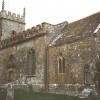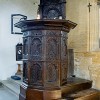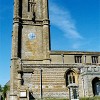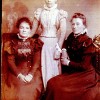The father of the bride did not approve of his daughter marrying the young man from Affpuddle but Betty Swetman went ahead anyway and married George Hand at St Osmond’s church, two days after Christmas 1804. Mr. Swetman’s fears proved unfounded and the couple appear to have enjoyed a happy marriage and had several children.
In 1835 their fifth child, Jemima, on returning from a stay in London, went to live near Stinsford, a parish a short distance from Dorchester, where she met a builder who she married on the 22nd of December 1839 at St. Osmond’s church. There is a framed copy of their marriage certificate displayed in the church. The following year the couple’s first child was born; he was given his father’s name and was destined to become Dorset’s most famous son: Thomas Hardy.
This unspoilt and picturesque village is approached along a weaving lane, lined with thatched stone cottages, many of which have stood here since the 17th century. The lane continues to a shallow ford where there is a small footbridge over the water.
The parish church dedicated to St. Osmond stands in the village. The west tower was built in the 15th century but, except for the tower-arch and some walling above it, this and the whole of the rest of the church was rebuilt in 1745, the cost born by Mrs Susanna Strangeways Horner. The chancel was rebuilt during restoration works in 1888 by Sir Arthur Bloomfield, in the style of the 13th century. The work was commissioned by the 5th Earl of Ilchester. Arthur Mee relates that in the 19th century “a font thought to be Norman was found built into the wall and is now in its place again, looking almost too new to be true.” The tower was home to five bells; in 1954 two of the bells were recast and the remaining three were retuned. The following year a new bell chamber was constructed and in 1967 a new treble bell was added.
In addition to the church the RCHM found a dozen 17th century cottages and several other buildings worthy of mention. In its history there was an extensive trade in plated buckles and horn buttons; dowlas (a course cloth) was manufactured here. Melbury comes from the Old English ‘maele’ and ‘burh,’ translated this means ‘many coloured fortified place,’ the suffix a reference to the dedication of the church.
In his novels and short stories Thomas Hardy called this village, “Kings Hintock and Little Hintock”.



